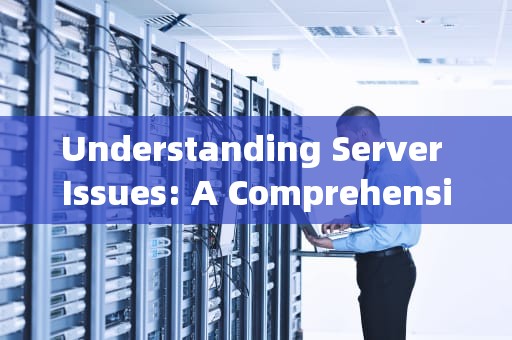In today's digital age, servers are the backbone of modern technology infrastructure. They host websites, applications, and databases, ensuring seamless operations for businesses and individuals alike. However, like any sophisticated machinery, servers are not immune to problems. Understanding these issues can help in troubleshooting and maintaining optimal server performance. This article delves into common server problems and their solutions.

Common Server Problems
1、Hardware Failures
Symptoms: Unexpected shutdowns, error messages related to hardware components, slow performance.
Causes: Faulty RAM, failing hard drives, overheating CPUs, or power supply issues.
Solutions: Regularly monitor server health using hardware diagnostic tools. Replace faulty components promptly. Ensure proper cooling and ventilation to prevent overheating.
2、Software Malfunctions
Symptoms: Crashes, blue screen errors, application failures, unusual behavior.
Causes: Software bugs, compatibility issues, corrupted files, or malware infections.
Solutions: Keep software up to date with the latest patches and updates. Use antivirus and anti-malware programs to scan for threats. Perform regular backups to restore data in case of corruption.
3、Network Connectivity Issues
Symptoms: Slow internet speed, intermittent connectivity, timeouts.
Causes: Faulty network cards, misconfigured network settings, ISP problems, or DNS issues.
Solutions: Check physical connections and ensure they are secure. Reconfigure network settings if necessary. Contact your ISP for support if external connectivity issues persist.
4、Performance Bottlenecks
Symptoms: Slow response times, high CPU or memory usage, long load times.
Causes: Insufficient resources, poorly optimized code, or high traffic volumes.
Solutions: Optimize server configuration by upgrading hardware or adding more resources. Implement caching mechanisms and optimize code for better performance. Consider load balancing to distribute traffic evenly.
5、Security Breaches
Symptoms: Unauthorized access, data breaches, unusual account activities.
Causes: Weak passwords, outdated security protocols, or exploited vulnerabilities.
Solutions: Implement strong authentication measures and use multi-factor authentication (MFA). Regularly update security patches and firewall rules. Conduct security audits and penetration testing to identify and fix vulnerabilities.
6、Configuration Errors
Symptoms: Services not starting, incorrect behavior of applications, permission issues.
Causes: Incorrect settings in configuration files, improper setup during installation, or changes made without proper documentation.
Solutions: Maintain detailed documentation of all configuration changes. Use version control for configuration files to track modifications. Regularly review and test configurations to ensure they align with current requirements.
7、Power Outages
Symptoms: Sudden server shutdowns, data loss, interrupted services.
Causes: Electrical grid failures, UPS (Uninterruptible Power Supply) issues, or power surges.
Solutions: Invest in a reliable UPS system to provide backup power during outages. Implement automatic failover systems to switch to backup power sources. Schedule regular maintenance checks for electrical infrastructure.
8、Human Error
Symptoms: Data corruption, accidental deletion of files, incorrect configuration settings.
Causes: Mistakes made by administrators or users while managing the server.
Solutions: Train staff on proper server management practices. Implement strict change management procedures and use role-based access controls to limit who can make critical changes. Regularly review audit logs to identify and correct errors promptly.
9、Compatibility Issues
Symptoms: Application crashes, missing features, unexpected behavior.
Causes: Incompatibility between different software versions, operating systems, or hardware components.
Solutions: Ensure that all software and hardware components are compatible before deployment. Test new updates and patches in a staging environment before applying them to production servers. Maintain a list of known compatible configurations for reference.
10、Resource Exhaustion
Symptoms: High disk usage, memory leaks, running out of available connections.
Causes: Insufficient allocation of resources, resource hogging processes, or unoptimized applications.
Solutions: Monitor resource usage regularly using tools like top, htop, or Task Manager. Optimize resource allocation based on observed patterns. Terminate unnecessary processes and consider upgrading hardware if needed.
Conclusion
Server problems can range from minor inconveniences to major disruptions, but with proper monitoring, maintenance, and proactive measures, many issues can be prevented or quickly resolved. By understanding the common causes of server problems and implementing effective solutions, organizations can ensure their servers remain reliable and efficient, supporting their critical operations without interruption.
随着互联网的普及和信息技术的飞速发展台湾vps云服务器邮件,电子邮件已经成为企业和个人日常沟通的重要工具。然而,传统的邮件服务在安全性、稳定性和可扩展性方面存在一定的局限性。为台湾vps云服务器邮件了满足用户对高效、安全、稳定的邮件服务的需求,台湾VPS云服务器邮件服务应运而生。本文将对台湾VPS云服务器邮件服务进行详细介绍,分析其优势和应用案例,并为用户提供如何选择合适的台湾VPS云服务器邮件服务的参考建议。

工作时间:8:00-18:00
电子邮件
1968656499@qq.com
扫码二维码
获取最新动态
